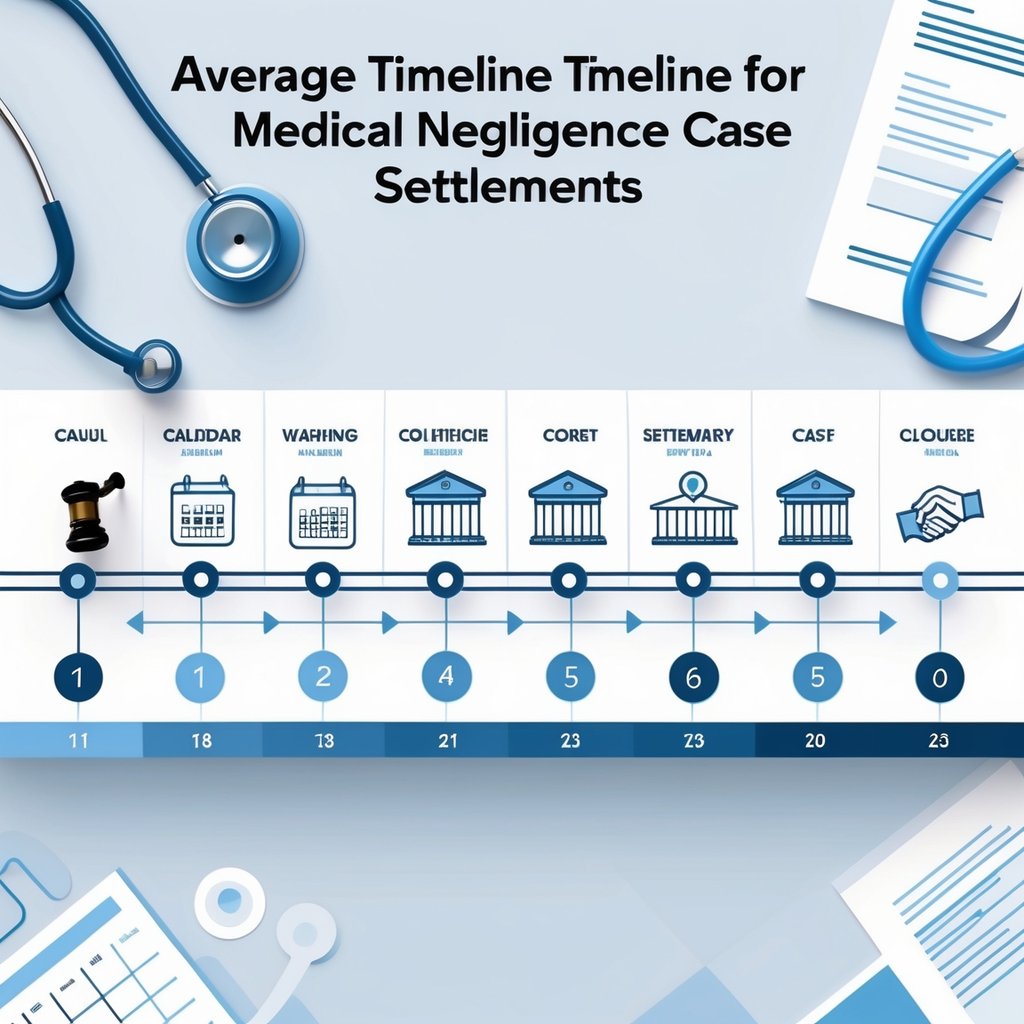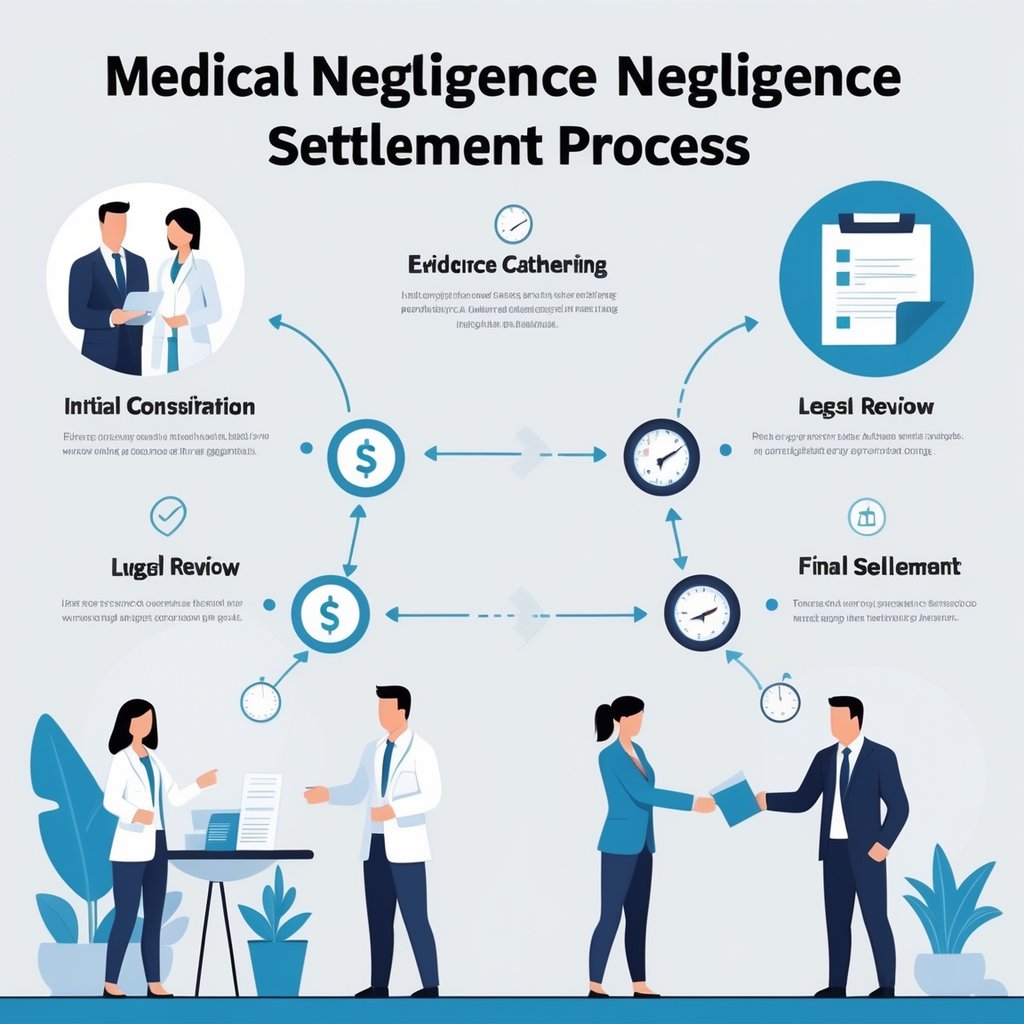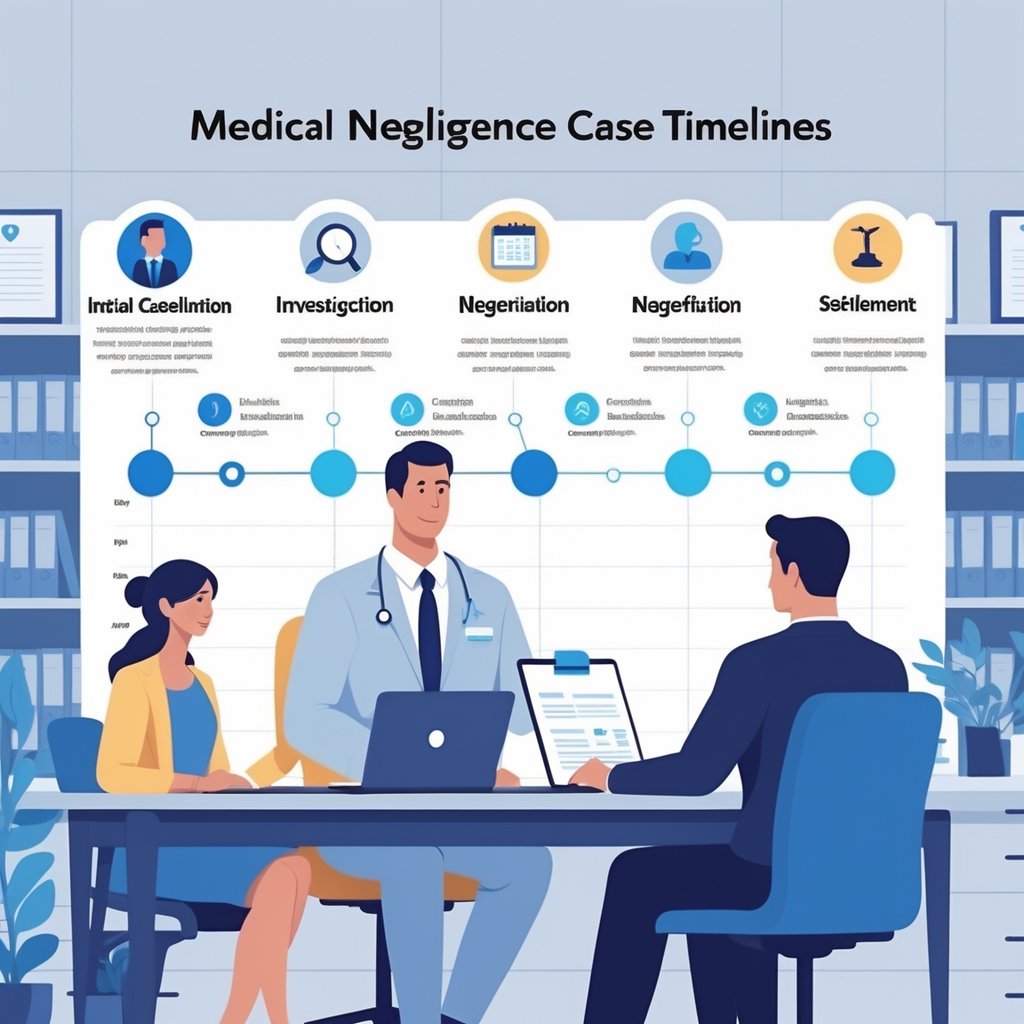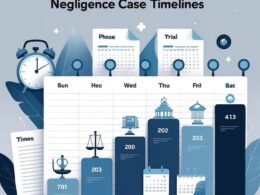When you’re facing a medical negligence case, you probably wonder how long the process will drag on. Most medical negligence cases take between 2 to 3 years to settle. Some straightforward cases might wrap up in under a year, while complex ones can stretch past 5 years.

Several things influence your timeline, like how complicated your medical issues are, how many people are involved, and if you settle or end up in court.
You’ll go through a bunch of phases, from the first investigation and filing to discovery, negotiations, and maybe even a trial. Each step brings its own headaches and can speed things up or slow everything way down.
Key Takeaways
- Medical negligence cases usually take 2-3 years to settle because of legal and medical complexity
- The discovery phase eats up the most time as both sides swap evidence and expert opinions
- Most cases settle before trial, often through negotiation or mediation, which can speed things up
Understanding Medical Negligence and Relevant Laws

Medical negligence happens when healthcare providers don’t meet accepted care standards and patients get hurt. To bring a legal claim, you have to prove certain elements under malpractice laws.
Definition of Medical Negligence
A doctor, nurse, or other provider commits medical negligence if they fail to give proper care. That failure must actually cause harm.
Four key elements must be there for medical negligence:
- Duty of care – The provider had a responsibility to treat you
- Breach of duty – They didn’t meet the standard of care
- Causation – Their actions directly led to your injury
- Damages – You suffered real harm or losses
The standard of care means what other reasonable providers would do in a similar situation. This can shift based on your condition and the type of provider.
Not every bad result is negligence. Medicine has risks. You have to show the provider acted below what other competent professionals would have done.
Legal Basis for Medical Malpractice Lawsuits
Medical malpractice claims fall under tort law, which deals with one person’s actions harming another.
State laws set most of the rules for these lawsuits. Each state decides things like:
- How much time you have to file
- Limits on money awards
- Rules for expert witnesses
- If you need to notify the provider before suing
Statute of limitations laws give you only so long to file. Most places allow 1-3 years from when you learned about the injury.
You almost always need expert testimony in medical malpractice cases. Medical experts explain how the provider failed and how that caused your injuries.
Some states want a certificate of merit before you file. A medical expert has to review your case and say malpractice probably happened.
Average Timeline for Medical Negligence Case Settlements

Most medical negligence cases take two to three years to resolve. The timeline changes depending on case complexity and who’s involved.
Typical Duration for Settlements
Average medical negligence claims take 12 to 36 months from start to finish. Still, studies show different numbers for the whole process.
A New England Journal of Medicine study found the average time between a healthcare injury and resolution was five years. That includes time before you even file.
In Maryland, the average time from filing to resolution is about 28 months. Most settlements come after discovery, once both sides have the facts.
Common Timeline Breakdown:
- Investigation and Filing: 3-6 months
- Discovery Phase: 12-18 months
- Settlement Negotiations: 6-12 months
Range of Timelines for Complex Cases
Complicated medical malpractice cases just take longer. The more complicated the case, the longer it drags on.
Factors that stretch out your case timeline include:
Case Complexity Factors:
- More than one healthcare provider involved
- Unusual medical or legal issues
- Lots of expert witnesses
- Fights over who’s really at fault
Cases with multiple defendants can last for years. If you sue several doctors, hospitals, or other folks, each one files their own motions and sits for depositions.
Finding witnesses, setting up interviews, and getting them done can take 1-3 months or even more. Doctors and nurses are busy, so getting them scheduled is a challenge.
The toughest cases can take five years or longer before you see any settlement. Negotiations can happen anytime, even right before a trial.
Key Stages in the Medical Negligence Settlement Process

The settlement process moves through three main phases. Each step builds your case and needs specific records and expert input.
Initial Consultation and Case Assessment
Your lawyer takes a look at your situation during the first meeting. They’ll ask about your medical care and what went wrong.
You’ll go over what happened and when you started noticing problems.
Key items your lawyer checks:
- Timeline of medical events
- Current health issues
- Any treatment records you have
- Names of doctors
This first meeting usually takes 2 to 4 weeks (timeline source). The lawyer figures out if your case has good potential.
Most attorneys offer a free consultation. They’ll tell you if you have a case.
You’ll hear about no-win, no-fee options, so you only pay if you win.
Gathering Medical Records and Evidence
Your attorney requests your medical records from hospitals and doctors. This step can take 2 to 6 months.
Records your lawyer collects:
- Hospital notes
- Surgery reports
- Lab results
- Prescription lists
- Nursing notes
- Discharge summaries
Some places send records fast, others drag their feet. You might wait weeks or even months.
Your lawyer might ask for witness statements. Family or friends who saw your condition can help.
Photos of injuries or medical devices can boost your case. Save anything that shows lost work or medical bills.
The attorney builds a timeline to show what went wrong and when.
Expert Medical Witness Evaluation
An expert medical witness reviews all your records. This doctor works in the same field as the one you’re claiming messed up.
The expert checks if mistakes happened and if those mistakes actually caused your injuries.
What the expert provides:
- Written report on errors
- Opinion about standard care
- Assessment of your injuries
- Testimony if you go to court
This review step takes 3 to 6 months (timeline info). Complicated cases might need more than one expert.
A strong expert report can push the other side to settle faster and pay more.
The Discovery Phase and Its Impact on Case Duration

The discovery phase usually drags the longest in medical malpractice lawsuits, sometimes lasting 6 months to a year and a half. This is when both sides gather evidence, take depositions, and swap documents.
Purpose and Scope of Discovery
Discovery lets both sides dig up all the facts before trial. You and your lawyer use this time to collect proof that medical negligence happened.
This stage includes medical records, expert opinions, and witness statements. Your team requests documents from hospitals, clinics, and the providers who treated you.
Discovery activities:
- Collecting medical records
- Finding expert witnesses
- Scheduling interviews
- Requesting evidence preservation
The defense does their own digging, too. They gather info to fight your claims. This back-and-forth makes things take longer but helps everyone prepare.
Complex cases need more discovery. Multiple doctors or rare conditions mean more investigation.
Role of Depositions and Witness Statements
Depositions are formal question sessions under oath, before trial. You’ll probably give a deposition about your treatment and injuries.
Your lawyer will question the providers involved. These meetings can last hours and take a lot of prep.
Expert witnesses get deposed, too. They explain complicated procedures and point out where care standards were missed.
Deposition participants:
- Patients – talk about symptoms and treatment
- Doctors – explain decisions
- Nurses – describe patient care
- Expert witnesses – offer opinions
Discovery can take 6 months to 1.5 years depending on how cooperative everyone is. Scheduling is a hassle, and witnesses can be tough to pin down.
Document Review and Evidence Exchange
Medical records are the backbone of your case. Your attorney has to review stacks of paperwork.
Hospital records, lab results, and scans all need careful checking. Experts take time to review everything and offer their take.
The other side asks for documents from you, too. That can include job records, past medical history, and insurance info.
Common documents exchanged:
- Full medical files
- Insurance and billing records
- Expert reports
- Treatment guidelines
Getting all these documents can take months. Sometimes hospitals or clinics respond slowly or send incomplete stuff.
Your legal team sorts through everything to find what matters. This deep review adds to the timeline but is a must for a solid case.
Settlement Negotiations and Resolution Procedures

Settlement negotiations are usually the main way people resolve medical negligence cases without a trial. Most cases get resolved through discussions between legal teams, and malpractice insurance companies often drive the offers and agreements.
Initiating Settlement Negotiations
Settlement talks can start at any point in your case. Negotiations might happen before you even file a lawsuit or during the trial itself.
Your attorney usually kicks things off by sending a demand letter to the defendant’s insurance company. This letter explains your injuries, medical costs, and damages.
Key timing options include:
- Pre-lawsuit phase: Negotiations before you file anything
- During discovery: After evidence gathering starts
- Pre-trial: Right before court starts
- During trial: Even while the case is underway
The insurance company reviews your claim and medical records. They look at liability and possible damages before making an offer.
Negotiations usually go back and forth several times. Your attorney counters their offer based on the strength of your evidence and any expert opinions.
Factors That Influence Settlement Offers
A few big things shape the size of your malpractice settlement offer. Insurance companies look at these when deciding how to negotiate.
Strong medical evidence makes a huge difference. If you can show clear negligence and causation, you’ll probably get a higher offer. Weak evidence means lower numbers.
Severity of damage also matters a lot. Permanent disability or death usually brings bigger settlements than minor injuries.
Expert witness quality can push insurance companies to offer more. If respected experts back your case, defendants feel more pressure.
Your attorney’s reputation can help too. Insurance companies tend to offer more to experienced malpractice lawyers with a history of winning.
Policy limits of the defendant’s insurance set a ceiling. Most doctors carry between $1 and $3 million per incident.
Outcomes: Settlement vs. Trial
Settlement benefits:
- Faster resolution and quicker payment
- Lower legal bills
- Guaranteed compensation
- More privacy
- Less stress
Trial brings:
- Longer wait and higher costs
- Unpredictable jury decisions
- Public records
- Maybe higher damages
- Risk of losing everything
Most settlements happen during discovery or right before trial. Insurance companies often raise their offers as trial gets closer to avoid court costs.
Your attorney will tell you if a settlement offer is fair. Sometimes it makes sense to reject a low offer and go to trial, but that brings more risk and delays.
Factors That Affect the Duration of Medical Negligence Cases

A handful of things really shape how long your medical negligence case will take. Case complexity can stretch out your timeline, since complicated medical facts need deeper investigation and more expert input.
Complexity of Medical Evidence
The kind of medical evidence you have changes how long your case drags on. Simple cases with clear records usually move faster.
Straightforward cases often mean:
- Obvious medical record mistakes
- Clear treatment errors
- Well-documented harm
- Just one healthcare provider involved
Complex cases might look like:
- Multiple specialties involved
- Disputed diagnoses or treatments
- Rare conditions
- Confusing cause-and-effect
Cases with tricky procedures or disputed diagnoses almost always take longer. Your team has to gather a pile of records, images, and treatment notes.
Getting experts ready can eat up a lot of time. Medical experts need to review everything, analyze, and prep their testimony. For tough cases, this can take months.
Disputes Over Liability or Damages
Arguments about who’s at fault or how much compensation is fair can really slow things down. If both sides can’t agree on the facts, cases drag out.
Liability disputes pop up when:
- More than one provider might be at fault
- People disagree on what counts as proper care
- It’s not clear if the treatment caused the injury
Damage disputes usually mean fighting over:
- Future medical costs
- Lost wages
- Pain and suffering
- How much disability is permanent
Settlement talks can last months if damages are hotly debated. Willingness to negotiate makes a big difference in how long things take.
Your attorney needs to build solid evidence for both fault and damages, which means more financial analysis and expert opinions.
Defendant and Insurance Company Cooperation
How fast your case moves often depends on the defendant and their insurance company. If they respond quickly, things move along. If not, expect delays.
Cooperative defendants:
- Hand over medical records quickly
- Make witnesses available
- Join settlement talks in good faith
- Follow court deadlines
Uncooperative parties:
- Stall on paperwork
- File lots of motions
- Refuse fair settlement offers
- Challenge everything
Insurance companies sometimes drag things out on purpose. They know that waiting can push injured patients to accept less money.
Your legal team has to stay on them. Sometimes you’ll need the court to step in and force them to cooperate.
Impact of Court Schedules and Legal Motions
Court calendars and legal steps can slow your case, no matter what you do. Trial length and appeals can also stretch things out.
Court schedule issues:
- Judge availability
- Trial calendar backups
- Holidays and vacations
- Emergency priorities
Common legal motions:
- Motions to dismiss challenge your case
- Discovery motions request more evidence
- Summary judgment tries to end the case early
- Expert challenges question if testimony is allowed
Each motion takes time—writing, hearings, waiting on decisions. Sometimes it adds weeks, sometimes months.
If your case actually goes to trial, expect it to last days or even weeks, depending on how complicated things are. Courts often schedule trials months after discovery ends.
Frequently Asked Questions

Medical negligence cases have certain timelines and steps that clients always want to know about. Most cases take two to three years, but really complicated ones can drag on even longer.
What is the typical timeline for a medical negligence case resolution?
Most medical negligence cases take between two and three years from start to finish. Some simple cases with clear facts might settle in less than a year.
Tougher cases with serious injuries or fights over liability might go on for several years. Some research says the average time from injury to resolution is five years.
How fast you can gather evidence and reach agreements really shapes your timeline.
Can the complexity of a case affect the duration of a medical negligence lawsuit?
Absolutely, complexity makes lawsuits take longer. Cases with lots of defendants or tricky medical issues just need more time.
Simple cases with obvious facts and clear fault usually settle quicker. When rare conditions or several providers are involved, things slow down.
If you need more expert witnesses, expect delays. More experts mean more depositions and longer discovery.
What are the common factors that can extend the settlement time of medical negligence claims?
A few things can make your case drag on. Getting medical records from different providers can be a headache.
Crowded court calendars and scheduling conflicts with lawyers and experts slow things down. Just the discovery phase can last a year or two.
If your injuries are severe and you’re still getting treatment, it’s tough to figure out final damages. That uncertainty can stall settlement talks until you’re stable.
How do pre-trial negotiations impact the settlement time for medical negligence cases?
Pre-trial negotiations can speed things up or slow them down. Sometimes early talks mean you settle in the first year.
If negotiations fall apart, it takes longer. Multiple rounds of talks and mediation can add months.
Most cases settle before trial. If you can negotiate a deal, you skip all the extra prep and court time.
Is there a standard statutory time limit for filing and settling medical negligence cases?
You have to file your case within a certain statute of limitations. This deadline changes by state but is usually one to three years from when you found out about the injury.
There’s no set time limit for settling after you file. Your case might take as long as it needs to wrap up through settlement or trial.
Some places require a 90-day pre-suit notice before you file. This gives the other side time to check out your claim.
How might the appeals process influence the overall time frame of a medical negligence case settlement?
If either party appeals the trial verdict, your case timeline stretches out. The appeals process can add another year or longer to the total duration.
Appeals bring written legal arguments and sometimes oral arguments before higher courts. This step demands more legal fees and drags out the uncertainty.
Most cases settle before anyone files an appeal. Still, large verdicts or hotly contested legal issues make appeals more likely.










